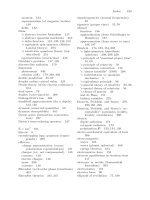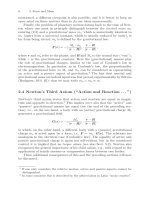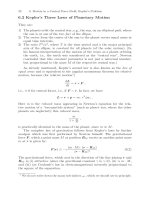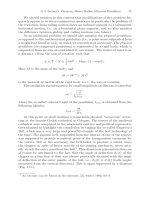- Trang chủ >>
- Khoa Học Tự Nhiên >>
- Vật lý
Basic Theoretical Physics: A Concise Overview P20 potx
Bạn đang xem bản rút gọn của tài liệu. Xem và tải ngay bản đầy đủ của tài liệu tại đây (264.67 KB, 10 trang )
21.3 Crystal Optics and Birefringence 191
On the one hand, the vector E should be perpendicular to the tangential
plane of the index ellipsoid viz by the Poinsot construction; on the other
hand it should belong to the plane defined by D and k. As one can show,
these two conditions can only be satisfied if the direction of D is a principal
direction of the above-mentioned section. This allows only two (orthogonal)
polarization directions of D; thus the two corresponding sets of dielectric
constants are also fixed. In general they are different from each other and the
corresponding phase velocities,
c
P
=
c
0
ε(D)
,
differ as well. (In addition, in general, the ray velocities (ˆ= group veloci-
ties) are different from the phase velocities, see above; i.e., two different ray
velocities also arise.)
Usually the incident wave has contributions from both polarizations. As
a consequence, even if in vacuo the wave has a unique linear polarization di-
rection (not parallel to a principal axis of the dielectric tensor), in the interior
of the crystal generally a superposition of two orthogonal linearly polarized
components arises, which propagate with different velocities.
The phenomenon becomes particularly simple if one is dealing with op-
tically uniaxial systems. In this case the index ellipsoid is an ellipsoid of
revolution, i.e., with two identical dielectric constants ε
1
≡ ε
2
and a different
value ε
3
. Under these circumstances one of the two above-mentioned polar-
ization directions of the vector D can be stated immediately, viz the direction
of the plane corresponding to
k × e
3
.
For this polarization one has simultaneously E ∼ D (i.e., also S ∼ k),
i.e., one is dealing with totally usual relations as in a vacuum (the so-called
ordinary beam). In contrast, for orthogonal polarization the vectors E and D
(and S and k) have different directions, so that one speaks of an extraordinary
beam.
If the phase-propagation vector k is, e.g., in the (x
1
,x
3
)-plane under a gen-
eral angle, then the in-plane polarized wave is ordinary,whereasthewave
polarized perpendicular to the plane is extraordinary. In the limiting cases
where (i) k is ∼ e
3
both waves are ordinary, whereas if (ii) k ∼ e
1
both
polarizations would be extraordinary.
For optically biaxial crystals the previous situation corresponds to the
general case.
It remains to be mentioned that for extraordinary polarizations not only
the directions but also the magnitudes of phase and ray velocities are differ-
ent, viz
v
phase
∝ k , with |v
phase
| =
c
0
ε(D)
192 21 Applications of Electrodynamics in the Field of Optics
in the first case, and
v
S
∝ S (for S = E × H) , with |v
S
| =
c
0
ε(E)
in the second case. In the first case we have to work with the D-ellipsoid
(index ellipsoid), in the second case with the E-ellipsoid (Fresnel ellipsoid).
21.4 On the Theory of Diffraction
Diffraction is an important wave-optical phenomenon. The word alludes to
the fact that it is not always possible to keep rays together. This demands
a mathematically precise description. We begin by outlining Kirchhoff’s law,
which essentially makes use of Green’s second integral theorem, a variant of
Gauss’s integral theorem. It starts from the identity:
u(r)∇
2
v(r) − v(r)∇
2
u(r)
≡∇·(u∇v −v∇u) ,
and afterwards proceeds to
V
dV
u∇
2
v −v∇
2
u
≡
∂V
d
2
An · (u∇v −v∇u) . (21.16)
This expression holds for continuous real or complex functions u(r)and
v(r), which can be differentiated at least twice, and it even applies if on the
l.h.s. of (21.16) the operator ∇
2
is replaced by similar operators, e.g.,
∇
2
→∇
2
+ k
2
.
Kirchhoff’s law (or “2nd law”, as it is usually called) is obtained by sub-
stituting
u(r)=
exp(ik|r −r
|)
|r −r
|
and v(r):=ψ(r)
into (21.16). Here r
is an arbitrary point in the interior of the (essentially
hollow) volume V (see below). As a consequence we have
∇
2
+ k
2
v(r) ≡ 0and
∇
2
+ k
2
u(r) ≡−4πδ(r − r
) .
Thus Kirchhoff ’s 2nd law states rigorously that
ψ(r
) ≡
∂V
d
2
A
4π
n(r) ·
e
ik|r−r
|
|r −r
|
∇ψ(r) − ψ(r)∇
e
ik|r−r
|
|r −r
|
. (21.17)
We assume here that the volume V is illuminated externally and that ∂V
contains an opening (or aperture) plus a “wall”. Only a small amount of the
light is diffracted from the aperture to those regions within the interior of
V in the geometrical shadow. Therefore it is plausible to make the following
approximations of (21.17)
16
:
16
a prerequisite is that the involved distances are λ.
21.4 On the Theory of Diffraction 193
a) only the aperture contributes to the integral in equation (21.17), and
b) within the aperture one can put
ψ(r) ≈
e
ik|r−r
Q
|
|r −r
Q
|
.
Here r
Q
is the position of a point light source outside the volume, which
illuminates the aperture. This is the case of so-called Fresnel diffraction.
(In the field of applied seismics, for example, one may be dealing with
a point source of seismic waves produced by a small detonation. Fresnel
diffraction is explained in Fig. 21.2 below.)
We then have
ψ(r
P
) ≈
−ik
2π
aperture
d
2
A
e
ikr
Q
r
Q
·
e
ikr
P
r
P
. (21.18)
Here r
Q
and r
P
are the distances between the source point r
Q
on the
left and the integration point r, and between integration point r and
observation point
r
P
≡ r
.
(Note that ∇
r
= −∇
r
Q
).
c) The situation becomes particularly simple when dealing with a planar
aperture illuminated by a plane wave
∝ e
ik
0
·r
(so-called Fraunhofer diffraction). We now have
|k
0
|
!
= k,
and for a point of observation
r
= r
P
behind the boundary ∂V (i.e., not necessarily behind the aperture, but
possibly somewhere in the shadow behind the “wall”):
ψ(r
P
) ≈ fe
ik
0
·r
aperture
d
2
A
exp(ik|r −r
P
|)
|r −r
P
|
(21.19)
Here f is a (noninteresting) factor.
Equation (21.19) is an explicit and particularly simple form of Huygens’
principle:Everypointoftheaperture gives rise to spherical waves, whose
effects are superimposed.
Two standard problems, which are special cases of (21.19) and (21.18),
should now be mentioned:
a) Fraunhofer diffraction at a single slit (and with interference,atadouble
slit). This case, which is discussed in almost all textbooks on optics, will
be treated later.
b) Fresnel diffraction at an edge. This problem is also important in the field
of reflection seismology when, for example, there is an abrupt shift in the
rock layers at a fault.
194 21 Applications of Electrodynamics in the Field of Optics
21.4.1 Fresnel Diffraction at an Edge; Near-field Microscopy
In the following we shall consider Fresnel diffraction at an edge.
Fresnel diffraction means that one is dealing with a point source. The
surface in shadow is assumed to be the lower part of a semi-infinite vertical
plane, given as follows:
x ≡ 0 ,y∈ (−∞, ∞) ,z∈ (−∞, 0] .
This vertical half-plane, with a sharp edge z ≡ 0, is illuminated by a point
source
r
Q
:= (−x
Q
,y
Q
, 0)
from a position perpendicular to the plane at the height of the edge, i.e., x
Q
is assumed to be the (positive) perpendicular distance from the illuminating
point to the edge. Additionally we assume
y
2
Q
x
2
q
, while y
P
≡ 0 .
The point of observation behind the edge is
r
P
:= (x
P
, 0,z
P
) ,
whereweassumex
P
> 0, whereas z
P
can be negative. In this case the point
of observation would be in the shadow; otherwise it is directly illuminated.
All distances are assumed to be λ. The situation is sketched in Fig. 21.2.
Fig. 21.2. Schematic diagram to illustrate Fresnel diffraction. In the diagram
(which we have intentionally drawn without using coordinates; see the text), rays
starting on the l.h.s. from a point source Q (e.g., Q =(−x
Q
,y
Q
,z
Q
)) are diffracted
at the edge of a two-dimensional half-plane (e.g., (0,y,z), with z ≤ z
Q
), from where
waves proceed to the observation point P , which belongs to the three-dimensional
space behind the plane (e.g., (x
P
,y
P
,z
P
), with x
P
> 0), for example, into the
shadow region (e.g., z
P
<z
Q
). In the directly illuminated region one observes
so-called fringes, as explained in the text
21.4 On the Theory of Diffraction 195
We then have for small values of y
2
and z
2
:
ψ(r
P
) ∼
∞
−∞
dy
∞
0
dz exp
ik ·
x
Q
+
(y −y
Q
)
2
+ z
2
2x
q
+ x
P
+
y
2
+(z −z
P
)
2
2x
p
, (21.20)
i.e., apart from a constant complex factor
ψ(r
P
) ∼
∞
0
dz exp
ik ·
z
2
2x
Q
+
(z −z
P
)
2
2x
P
. (21.21)
By substitution, this result can be written (again apart from a complex
factor
17
of order of magnitude 1)
ψ(r
P
) ∼
∞
−w
dηe
iη
2
, (21.22)
with the w-parameter
w := z
P
·
k ·x
q
2x
P
(x
P
+ x
Q
)
. (21.23)
One thus obtains for the intensity at the point of observation:
I =
I
0
2
2
π
∞
−w
dηe
iη
2
2
. (21.24)
The real and imaginary parts of the integral I(w) appearing in (21.24) define
the Fresnel integrals C(w)andS(w):
C(w)+
1
2
:=
2
π
∞
−w
cos(η
2
)dη, S(w)+
1
2
:=
2
π
∞
−w
sin(η
2
)dη, or
C(w)=
2
π
w
0
cos(η
2
)dη, S(w)=
2
π
w
0
sin(η
2
)dη,
and the closely related Cornu spiral, which is obtained by plotting S(w)over
C(w), while w is the line parameter of the spiral; cf. Sommerfeld, [14], or
Pedrotti et al., Optics, [15], Fig. 18.17
18
.
17
Landau-Lifshitz II (Field theory (sic)), chapter 60
18
Somewhat different, but equivalent definitions are used by Hecht in [16].
196 21 Applications of Electrodynamics in the Field of Optics
An asymptotic expansion of (21.24), given, e.g., in the above-mentioned
volume II of the textbook series by Landau and Lifshitz, [8], yields
I(w)
I
0
∼
=
1
4πw
2
for w 0
1+
1
π
sin(w
2
−
π
4
)
w
2
for w 0
. (21.25)
A more detailed calculation also yields intermediate behavior, i.e., a smooth
function that does not jump discontinuously from 1 to 0, when the geomet-
rical shadow boundary is crossed, but which increases monotonically from
(I/I
0
)=0forw = −∞ (roughly ∼ 1/w
2
) up to a maximum amplitude
(I/I
0
) ≈ 1.37 for w ≈
3π
4
(The characteristic length scale for this monotonic increase is of the order of
half a wavelength), and then oscillates about the asymptotic value 1, with
decreasing amplitude and decreasing period: In this way fringes appear near
the shadow boundary on the positive side (cf. Fig. 12 in Chap. 60 of volume II
of the textbook series by Landau and Lifshitz, [8]), i.e. with an envelope-decay
length Δz
P
which obeys the equation
(Δz
P
)
2
x
Q
λ2x
P
·(x
P
+ x
Q
)
≡ 1 ,
and which is therefore not as small as one might naively believe (in particular
it can be significantly larger than the characteristic length
λ
2
for the above-
mentioned monotonic increase), but which is
Δz
P
:=
2λ · (x
Q
+ x
P
) ·
x
P
x
Q
.
Thus, even if the edge of the shadowing plane were atomically sharp, the
optical image of the edge would not only be unsharp (as naively expected)
on the scale of a typical “decay length” of the light (i.e., approximately on the
scale of
λ
2
,whereλ is the wavelength) but also on the scale of unsharpness
Δz
P
, which is significantly larger
19
. The signal would thus be alienated and
disguised by the above long-wavelength fringes. In our example from seismo-
logy, however, a disadvantage can be turned into an advantage, because from
the presence of fringes a fault can be discovered.
19
This enlargement of the scale of unsharpness through the oscillating sign of the
fringes is a similar effect to that found in statistics, where for homogeneous cases
one has a 1/N -behavior of the error whereas for random signs this changes to
1/
√
N-behavior, which is significantly larger.
21.4 On the Theory of Diffraction 197
The fact that the accuracy Δx of optical mappings is roughly limited to
λ
2
follows essentially from the above relations. In expressions of the form
exp(ik · Δx)
the phases should differ by π, if one wants to resolve two points whose posi-
tions differ by Δx.With
k =
2π
λ
this leads to Δx ≈
λ
2
.
This limitation of the accuracy in optical microscopy is essentially based on
the fact that in microscopy usually only the far-field range of the electromag-
netic waves is exploited.
Increased accuracy can be gained using near-field microscopy (SNOM ≡
Scanning Near Field Optical Microscopy). This method pays for the advan-
tage of better resolution by severe disadvantages in other respects
20
, i.e.,
one has to scan the surface point by point with a sharp micro-stylus: elec-
tromagnetic fields evolve from the sharp point of the stylus. In the far-field
range they correspond to electromagnetic waves of wavelength λ, but in the
near-field range they vary on much shorter scales.
21.4.2 Fraunhofer Diffraction at a Rectangular and Circular
Aperture; Optical Resolution
In the following we shall treat Fraunhofer diffraction, at first very generally,
where we want to show that in the transverse directions a Fourier transfor-
mation is performed. Apart from a complex factor, (for distances λ)the
equality (21.19) is identical with
ψ(r
P
) ∝
aperture
d
2
re
i(k
0
−k
P
)·r
. (21.26)
(If the aperture, analogous to an eye, is filled with a so-called “pupil function”
P (r), instead of (21.26) one obtains a slightly more general expression:
ψ ∝
aperture
d
2
rP (r)e
i(k
0
−k
P
)·r
.)
Here k
P
is a vector of magnitude k and direction r
P
, i.e., it is true for r
P
r
that
exp(ik|r −r
P
|)
∼
=
exp[ikr
P
− i(r
p
·r)/r
P
] ,
20
Thereissomekindofconservation theorem involved in these and other problems,
i.e. again the theorem of conserved effort.
198 21 Applications of Electrodynamics in the Field of Optics
such that apart from a complex factor, the general result (21.19) simplifies
to the Fourier representation (21.26).
For the special case of a perpendicularly illuminated rectangular aperture
in the (y, z)-plane one sets
k
0
= k ·(1, 0, 0)
and also
k
P
= k ·
1 − sin
2
θ
2
− sin
2
θ
3
, sin θ
2
, sin θ
3
,
and obtains elementary integrals of the form
a
j
/2
−a
j
/2
dy
j
e
−i(sin θ
j
)·y
j
.
In this way one finds
ψ(r
P
) ∝ a
2
a
3
·
3
j=2
(sin θ
j
) ·
a
j
π
λ
a
j
π
λ
. (21.27)
The intensity is obtained from ψ · ψ
∗
.
For a circular aperture with radius a one obtains a slightly more compli-
cated result:
ψ(r
P
) ∝ πa
2
·
2J
1
2π ·(sin θ) ·
a
λ
2π ·(sin θ) ·
a
λ
, (21.28)
where J
1
[x] is a Bessel function. In this case the intensity has a sharp maxi-
mum at sin θ = 0 followed by a first minimum at
sin θ =0.61
λ
a
,
so that the angular resolution for a telescope with an aperture a is limited
by the Abb´eresult
sin θ ≥ 0.61
λ
a
.
In this case too, diffraction effects limit the resolution to approximately
λ
2
.
21.5 Holography 199
21.5 Holography
Hitherto we have not used the property that electromagnetic waves can in-
terfere with each other, i.e., the property of coherence:
j
ψ
j
2
≡
j,k
ψ
∗
j
ψ
k
, and not simply ≡
j
|ψ
j
|
2
.
(The last expression – addition of the intensities – would (in general) only
be true, if the phases and/or the complex amplitudes of the terms ψ
j
were
uncorrelated random numbers, such that from the double sum
j,k
ψ
∗
j
ψ
k
only
the diagonal terms remained.)
If the spatial and temporal correlation functions of two wave fields,
C
1,2
:=
ψ
(1)
∗
(r
1
,t
1
)ψ
(2)
(r
2
,t
2
)
≡
k
1
,k
2
c
(1)
k
1
∗
e
−i(k
1
·r
1
−ωt
1
)
c
(2)
k
2
e
i(k
2
·r
2
−ωt
2
)
, (21.29)
decay exponentially with increasing spatial or temporal distance, viz
C
1,2
∝ e
−
“
|r
1
−r
2
|
l
c
+
(t
1
−t
2
)
τ
c
”
,
then the decay length l
c
and decay time τ
c
are called the coherence length
and coherence time, respectively.
Due to the invention of the laser one has gained light sources with macro-
scopic coherence lengths and coherence times. (This subject cannot be treated
in detail here.)
For photographic records the blackening is proportional to the intensity,
i.e., one loses the information contained in the phase of the wave. Long before
the laser was introduced, the British physicist Dennis Gabor (in 1948) found
a way of keeping the phase information intact by coherent superposition of
the original wave with a reference wave, i.e., to reconstruct the whole (→
holography) original wave field ψ
G
(r,t)
21
from the intensity signal recorded
by photography. However, it was only later (in 1962) that the physicists Leith
and Upatnieks at the university of Michigan used laser light together with the
“off-axis technique” (i.e., oblique illumination) of the reference beam, which
is still in use nowadays for conventional applications
22
.
21
This means that ψ
G
(r,t) is obtained by illuminating the object with coherent
light.
22
Nowadays there are many conventional applications, mainly in the context of
security of identity cards or banknotes; this is treated, e.g., in issue 1, page 42,
of the German “Physik Journal”, 2005, see [17]
200 21 Applications of Electrodynamics in the Field of Optics
The conventional arrangement for recording optical holograms is pre-
sented, for example, in Fig. 13.2 of the textbook by Pedrotti and coworkers.
The hologram, using no lenses at all (!), measures the blackening function of
a photographic plate, which is illuminated simultaneously by an object wave
and a reference wave.
As a consequence, the intensity I corresponds to the (coherent) superpo-
sition of (i) the object wavefunction ψ
G
and (ii) the reference wave
∼ e
ik
0
·r
, i.e., I ∝|ψ
G
+ a
0
exp (i(k
0
·r)|
2
.
In particular, the intensity I does not depend on time, since all waves are
∝ e
−iωt
.
If the terms ∝ a
0
, ∝ a
∗
0
and ∝|a
0
|
2
dominate, one thus obtains
I ∝|a
0
|
2
+ a
0
e
ik
0
·r
ψ
G
(r)+a
∗
0
e
−ik
0
·r
ψ
∗
G
(r)(→ I
hologram
) , (21.30)
where additionally one has to multiply with the blackening function of the
photographic emulsion.
The second term on the r.h.s. of (21.30) is just the object wave field while
the third term is some kind of “conjugate object field” or “twin field”, which
yields a strongly disguised picture related to the object (e.g., by transition to
complex-conjugate numbers, e
iΦ(r)
→ e
−iΦ(r)
, points with lower coordinates
and points with higher coordinates are interchanged).
It is thus important to view the hologram in such a way that out of
the photograph of the whole intensity field I
hologram
the second term, i.e.,
the object field, is reconstructed. This is achieved, e.g., by illuminating the
hologram with an additional so-called reconstruction wave
∝ e
−i k
1
·r
(e.g., approximately opposite to the direction of the reference wave, k
1
≈ k
0
).
In the coherent case one thus obtains
I
view
∝|a
0
|
2
e
−i k
1
·r
+ a
0
ψ
G
(r)e
i(k
0
−k
1
)·r
+ a
∗
0
ψ
∗
G
(r)e
−i(k
0
+k
1
)·r
. (21.31)
For suitable viewing one mainly sees the second term on the r.h.s., i.e., exactly
the object wave field.









